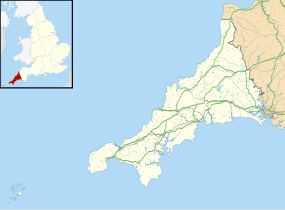Trethevy Quoit

Trethevy Quoit viewed from the northwest
|
|
| Location | St Cleer, Cornwall |
|---|---|
| Coordinates | 50°29′35″N 4°27′19″W / 50.49317°N 4.45539°W |
| Type | Dolmen |
| History | |
| Periods | Neolithic |
Trethevy Quoit (Cornish: Koyt Tredhewi) is a well-preserved megalithic tomb that lies between St Cleer and Darite in Cornwall, England, United Kingdom. It is known locally as "the giant's house". Standing 9 feet (2.7 m) high, it consists of five standing stones capped by a large slab.
Trethevy Quoit is north of Liskeard in the hamlet of Tremar Coombe. Trethevy farmhouse is a Grade II* listed building. Nearby are The Hurlers, three stone circles dating from the late Bronze Age. The site is managed by the Cornwall Heritage Trust on behalf of English Heritage.
Like other portal tombs of this type, Trethevy Quoit was originally covered by a mound. The remnants of this suggest a diameter of 6.5 metres. The remaining seven stones and the 3.7 m long and 10.5-ton cover slab were inside the mound. At the upper end of the cover slab is a natural hole, which may have been used for astronomical observation. The group of horizontal stones is composed of a fallen back wall, two side wall stones, which overlap, a front stone and a somewhat remote flanking stone. The special feature of Cornish portal graves is that by such stones sometimes a smaller partially closed area is created before the front end. Some stones have hole-like perforations as decoration. The front stone is often called an entrance stone, although in most portal graves this can not be moved. The Trevethy Quoit is a rare exception here, because a small rectangular stone moving at the bottom right of the front allows access to the grave chamber, which is now opened only very rarely. The back of the chamber has collapsed inwards and now forms a pile inside the chamber. Erected this stone would be about the height of the front stone, so that the cover slab would not have once been held-up by the side stones, but rested almost horizontal solely on the front stone and rear walls. However, there would have been between the support stones and the side walls a considerable gap, by which soil could have penetrated into the grave chamber. It is therefore likely that the collapse of the rear wall and the falling-down of the cover slab damaged the side stones.
...
Wikipedia

